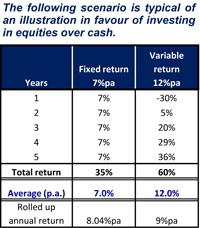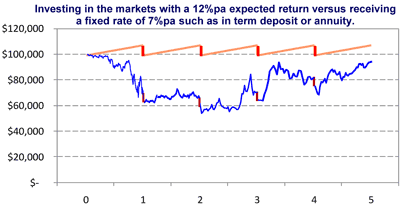Having managed a team of planners for a number of years, one of the common mistakes I have seen with both advisers and retirees is the assumption that a 12%pa average return in equities is better than a fixed return of 7%pa from cash.
For the most part, that’s not a bad assumption to make as we know that sharemarket returns are typically volatile but tend to outperform cash over the longer term.
As financial planners we are taught to expect that clients in retirement should take less risk. However, there is an assumption amongst many that the primary difference in attitude to risk between a retiree and non-retiree is mainly due to their age and the same investments are suitable with a small tweaking to reduce the risk slightly. “After all, if the markets fall, when they eventually recover the client is likely to be better off.”

This makes a compelling argument for equities over cash, especially when you consider that cash rates of 7%pa are considered relatively high (used for the purposes of this illustration).
Even if you were to consider the effect of rolling your returns, a fixed 7%pa produces provides an overall annual return of 8.04%pa, whereas the variable return (12% average used in this example) still produces 9%pa. There is therefore no doubt that higher variable returns are more beneficial than lower fixed returns for those that do not need an income.
Sharemarket falls have a much larger impact on the viability of your portfolio when drawing an income
What many planners and investors fail to realise is the significant effect that drawing an income has on sustaining this growth. There is an assumption that if you draw an income of 7%pa and maintain an average growth in your portfolio of 12%pa that your fund will always be able to fund your 7%pa requirement.
However, this is simply not the case. Drawing a fixed income once your portfolio has had a significant fall (such as what we have seen in the last 2 years), can significantly affect the portfolio’s ability to provide an ongoing income and illustrates the need for reduced risk in structuring a portfolio.
The thought process that increasing risk to produce greater returns doesn’t always fit and investors can easily find themselves increasing risk and reducing their returns.
Case Study
To illustrate this point we used an investment simulator to look at possible outcomes for $100k investment with an income requirement of $7k pa.
What we found, and is arguably typical of the scenario many post GFC retirees now find themselves in, is an unsustainable portfolio being eroded by the need for income.

Unlike, non-income investors, those in need of an income, are unable to sit on the sidelines and wait for the sharemarket to recover before resuming an income.
Investing for income should therefore have a much greater consideration for capital preservation than other types of strategies, after all, those reliant upon the income generally don’t have the luxury of a second chance if they get it wrong.
This issue sees us featuring CommInsure and Challenger, Lifetime Annuities, providing investors with a fixed income for life, regardless of how long they live for.
We have also featured Axa North, Retirement Guarantee Option, offering investors a guaranteed income for life but with the added benefit of participating in a rising sharemarket.
Feature on CommInsure and Challenger Annuities
Feature on Axa North Retirement Guarantee Option

Comment: